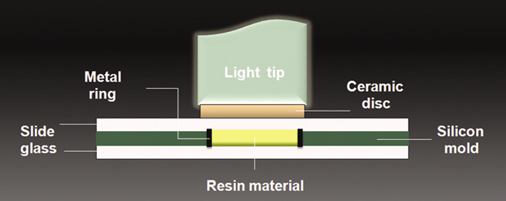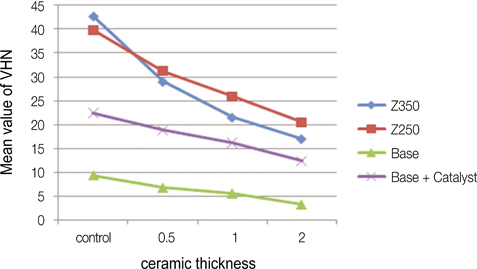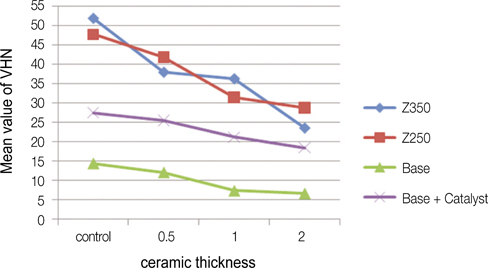J Adv Prosthodont.
2011 Sep;3(3):126-131. 10.4047/jap.2011.3.3.126.
Curing efficiency of various resin-based materials polymerized through different ceramic thicknesses and curing time
- Affiliations
-
- 1Department of Dentistry, College of Medicine, University of Ulsan, Ulsan, Korea. dentljh@yahoo.co.kr
- KMID: 2118120
- DOI: http://doi.org/10.4047/jap.2011.3.3.126
Abstract
- PURPOSE
The aim of this in vitro study was to examine the curing efficiency of various resin-based materials polymerized through ceramic restorations with 3 different thicknesses. Curing efficiency was evaluated by determining the surface microhardness (VHN) of the resin specimens.
MATERIALS AND METHODS
Four kinds of resin materials were used. Z350 (3M ESPE Filtek(TM) Z350: A2 Shade), Z250 (3M ESPE Filtek(TM) Z250: A2 Shade) and Variolink(R) II (VL: Ivoclar vivadent, base: transparent) either with or without a self-curing catalyst (VLC: Ivoclar vivadent, catalyst: low viscosity/transparent) were filled into the silicone mold (10 mm diameter, 1 mm thick). They were cured through ceramic discs (IPS e.max Press MO-0 ingot ivoclar vivadent, 10 mm diameter, 0.5, 1 and 2 mm thicknesses) by LED light-curing units for 20 and 40 seconds. Vicker's microhardness numbers (VHNs) were measured on the bottom surfaces by a microhardness tester. Data were analyzed using a 3- way analysis of variance (ANOVA) at a significance level of 0.05.
RESULTS
The thickness of ceramic disc increased, the VHNs of all four resin types were decreased (P<.05). The mean VHN values of the resins light cured for 40 seconds were significantly higher than that of LED for 20 seconds in all four resin materials (P<.05). VLC showed significantly higher VHN values than VL regardless of other conditions (P<.05). Z350 and Z250 showed higher values than VL or VLC (P<.01).
CONCLUSION
Thinner ceramic disc with increased curing time resulted higher VHN values of all resin materials. The use of a catalyst produced a greater hardness with all polymerization methods. Restorative resin materials (Z350, Z250) showed higher VHN values than resin cement materials (VL, VLC).
Keyword
MeSH Terms
Figure
Reference
-
1. Asmussen E. Restorative resins: hardness and strength vs. quantity of remaining double bonds. Scand J Dent Res. 1982. 90:484–489.2. Caughman WF, Caughman GB, Shiflett RA, Rueggeberg F, Schuster GS. Correlation of cytotoxicity, filler loading and curing time of dental composites. Biomaterials. 1991. 12:737–740.3. El-Mowafy OM, Rubo MH. Influence of composite inlay/onlay thickness on hardening of dual-cured resin cements. J Can Dent Assoc. 2000. 66:147.4. Cheong C, King NM, Pashley DH, Ferrari M, Toledano M, Tay FR. Incompatibility of self-etch adhesives with chemical/dual-cured composites: two-step vs one-step systems. Oper Dent. 2003. 28:747–755.5. Suh BI, Feng L, Pashley DH, Tay FR. Factors contributing to the incompatibility between simplified-step adhesives and chemically-cured or dual-cured composites. Part III. Effect of acidic resin monomers. J Adhes Dent. 2003. 5:267–282.6. Calamia JR, Calamia CS. Porcelain laminate veneers: reasons for 25 years of success. Dent Clin North Am. 2007. 51:399–417.7. Garber DA, Goldstein RE. Porcelain and composite inlays and onlays: esthetic posterior restorations. 1994. Chicago: Quintessence Publishing Co.8. Strang R, Macdonald I, O'Hagan S, Murray J, Stephen KW. Variations in performance of curing light units by determination of composite resin setting time. Br Dent J. 1987. 162:63–65.9. Blackman R, Barghi N, Duke E. Influence of ceramic thickness on the polymerization of light-cured resin cement. J Prosthet Dent. 1990. 63:295–300.10. Peutzfeldt A, Asmussen E. The effect of postcuring on quantity of remaining double bonds, mechanical properties, and in vitro wear of two resin composites. J Dent. 2000. 28:447–452.11. Pianelli C, Devaux J, Bebelman S, Leloup G. The micro-Raman spectroscopy, a useful tool to determine the degree of conversion of light-activated composite resins. J Biomed Mater Res. 1999. 48:675–681.12. Shortall AC, Harrington E. Effect of light intensity on polymerisation of three composite resins. Eur J Prosthodont Restor Dent. 1996. 4:71–76.13. Koch A, Kroeger M, Hartung M, Manetsberger I, Hiller KA, Schmalz G, Friedl KH. Influence of ceramic translucency on curing efficacy of different light-curing units. J Adhes Dent. 2007. 9:449–462.14. Hooshmand T, Mahmoodi N, Keshvad A. Microhardness of a resin cement polymerized by light-emitting diode and halogen lights through ceramic. J Prosthodont. 2009. 18:411–416.15. Hofmann N, Papsthart G, Hugo B, Klaiber B. Comparison of photo-activation versus chemical or dual-curing of resin-based luting cements regarding flexural strength, modulus and surface hardness. J Oral Rehabil. 2001. 28:1022–1028.16. Rueggeberg FA, Craig RG. Correlation of parameters used to estimate monomer conversion in a light-cured composite. J Dent Res. 1988. 67:932–937.17. Rueggeberg FA, Ergle JW, Mettenburg DJ. Polymerization depths of contemporary light-curing units using microhardness. J Esthet Dent. 2000. 12:340–349.18. Magne P, Belser U. Bonded porcelain restorations in the anterior dentition-a biomimetic approach. 2002. Chicago: Quintessence Publishing Co.19. Jung H, Friedl KH, Hiller KA, Haller A, Schmalz G. Curing efficiency of different polymerization methods through ceramic restorations. Clin Oral Investig. 2001. 5:156–161.20. Rasetto FH, Driscoll CF, von Fraunhofer JA. Effect of light source and time on the polymerization of resin cement through ceramic veneers. J Prosthodont. 2001. 10:133–139.21. Santos GC Jr, El-Mowafy O, Rubo JH, Santos MJ. Hardening of dual-cure resin cements and a resin composite restorative cured with QTH and LED curing units. J Can Dent Assoc. 2004. 70:323–328.22. Moon HJ, Lee YK, Lim BS, Kim CW. Effects of various light curing methods on the leachability of uncured substances and hardness of a composite resin. J Oral Rehabil. 2004. 31:258–264.23. O'Keefe KL, Pease PL, Herrin HK. Variables affecting the spectral transmittance of light through porcelain veneer samples. J Prosthet Dent. 1991. 66:434–438.24. Brodbelt RH, O'Brien WJ, Fan PL. Translucency of dental porcelains. J Dent Res. 1980. 59:70–75.25. Akgungor G, Akkayan B, Gaucher H. Influence of ceramic thickness and polymerization mode of a resin luting agent on early bond strength and durability with a lithium disilicate-based ceramic system. J Prosthet Dent. 2005. 94:234–241.26. Rueggeberg FA, Caughman WF. The influence of light exposure on polymerization of dual-cure resin cements. Oper Dent. 1993. 18:48–55.27. van Meerbeek B, Inokoshi S, Davidson CL, De Gee AJ, Lambrechts P, Braem M, Vanherle G. Dual cure luting composites-Part II: Clinically related properties. J Oral Rehabil. 1994. 21:57–66.
- Full Text Links
- Actions
-
Cited
- CITED
-
- Close
- Share
- Similar articles
-
- Comparison of light transmittance in different thicknesses of zirconia under various light curing units
- Comparison of the degree of conversion of light-cured resin cement in regard to porcelain laminate thickness, light source and curing time using FT-IR
- Evaluation of High-power Light Emitting Diode Curing Light on Sealant Polymerization
- Comparison of Surface Microhardness of the Flowable Bulk-Fill Resin and the Packable Bulk-Fill Resin according to Light Curing Time and Distance
- Translucency changes of direct esthetic restorative materials after curing, aging and treatment




